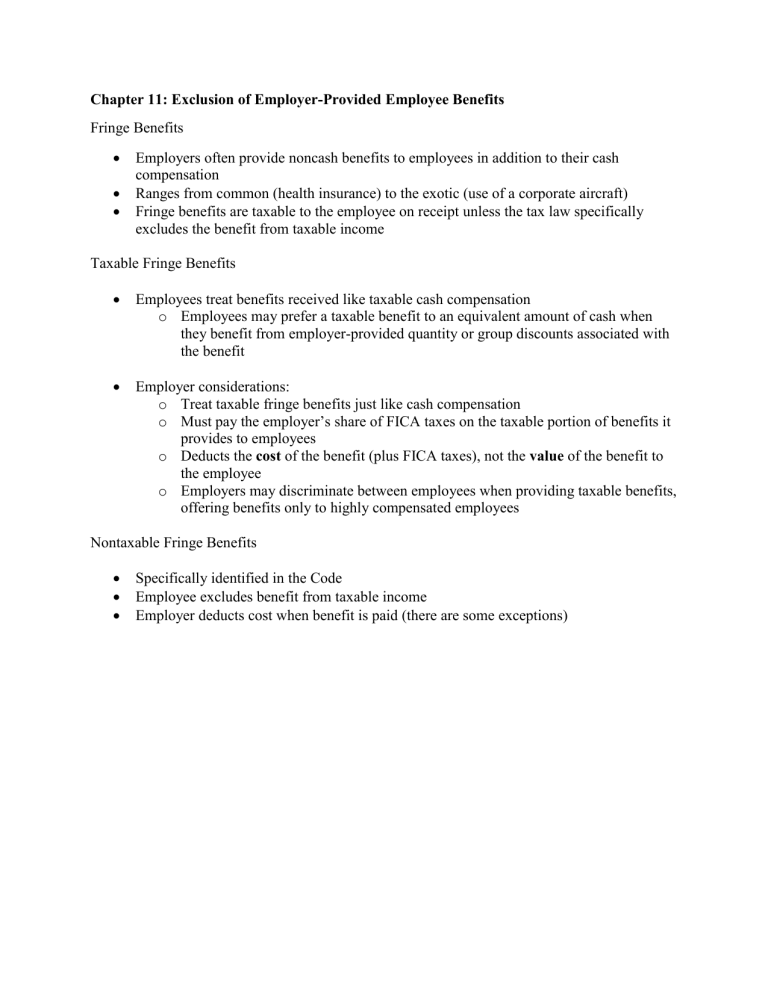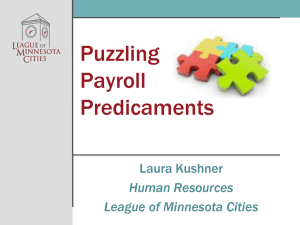
Chapter 11: Exclusion of Employer-Provided Employee Benefits Fringe Benefits Employers often provide noncash benefits to employees in addition to their cash compensation Ranges from common (health insurance) to the exotic (use of a corporate aircraft) Fringe benefits are taxable to the employee on receipt unless the tax law specifically excludes the benefit from taxable income Taxable Fringe Benefits Employees treat benefits received like taxable cash compensation o Employees may prefer a taxable benefit to an equivalent amount of cash when they benefit from employer-provided quantity or group discounts associated with the benefit Employer considerations: o Treat taxable fringe benefits just like cash compensation o Must pay the employer’s share of FICA taxes on the taxable portion of benefits it provides to employees o Deducts the cost of the benefit (plus FICA taxes), not the value of the benefit to the employee o Employers may discriminate between employees when providing taxable benefits, offering benefits only to highly compensated employees Nontaxable Fringe Benefits Specifically identified in the Code Employee excludes benefit from taxable income Employer deducts cost when benefit is paid (there are some exceptions) Common Nontaxable (Tax-Free) Fringe Benefits 1. Accident and Health Plans Premiums paid for health and accident insurance as well as benefits received by the employee under such insurance plan are excluded from an employee’s gross income. Recall the rules for disability insurance explained in Chapter 10 2. Cafeteria Plans Allow employees to select which benefits best fit their needs Employees can choose between nontaxable fringe benefits or cash If the employee chooses the cash option, the benefit is included in gross income 3. Dependent Care Assistance Employees can exclude up to $5,000 ($2,500 if MFS) Plan cannot discriminate in favor of highly compensated employees Employers must notify employees of the plan 4. Educational Assistance Employees can exclude up to $5,250 per calendar year Plan cannot discriminate in favor of highly compensated employees Employers must notify employees of the plan Qualified expenses include tuition, fees, books, supplies, and equipment, but not meals, lodging, and transportation 5. Adoption Assistance An employee's gross income does not include amounts paid or expenses incurred by the employer under an adoption assistance program Employees can exclude up to $14,080 in 2019 This exclusion phases out for high income taxpayers 6. Retirement Plan Contributions (e.g. 401(k) plan) Employee contributions are not taxable Limited to $19,000 in 2019 Employer contributions are not taxable Overall limit (employee plus employer contributions) is the lesser of 100% of compensation or $56,000 in 2019 Contributions and investment earnings are not taxable until the employee withdraws money from the account (investment grows tax free) ROTH 401(k) plans have different rules 7. Meals and Lodging The value of employer provided meals and lodging (provided on the employer’s premises) is excluded from gross income as long as the benefit is provided for the convenience of the employer In the case of lodging, the employee must be required to accept the lodging as a condition of his/her employment Employer’s deduction for meals is limited to 50%, no employer deduction beginning in 2026 8. Section 132 Fringe Benefits Gross income shall not include any fringe benefit which qualifies as a: No-Additional-Cost Service: If an employer provides a service to an employee and the service is normally offered to customers in the ordinary course of business of the employer, AND the employer incurs no substantial additional cost, the value of the service is excluded from the employee’s gross income (airlines, hotels, etc.) Qualified Employee Discount: The exclusion depends on whether the discount is for services or products Regarding discounted services, employees can exclude a discount up to 20% of the price the employer normally charges customers Regarding discounted products, employees can exclude a discount up to the value of the employer’s gross profit percentage Working Condition Fringe: Includes benefits such as a company car, employer-provided cell phone, in house training (education); employees can exclude the value of these benefits from gross income The value of any personal use of these items is generally included in an employee’s gross income De Minimis Fringe: The value of small benefits are excluded from an employee’s gross income – for example, coffee, company picnics, occasional personal use of the office copy machine, etc. Qualified Transportation Fringe: Employees can exclude: $265/month for transit passes $265/month for parking expenses Employers do not receive a deduction for providing these benefits Qualified Moving Expense Reimbursement: Suspended through 2025 Qualified Retirement Planning Services 9. Group Term Life Insurance Premiums Employers can generally exclude the cost of up to $50,000 of group-term life insurance from the wages of an insured employee. Ken is 63 years old and unmarried. He retired at age 55 when he sold his business, Understock.com. Though Ken is retired, he is still very active. Ken reported the following financial information this year. Assume Ken files as a single taxpayer. Determine Ken’s gross income. a. Ken won $1,200 in an illegal game of poker (the game was played in Utah, where gambling is illegal). b. Ken sold 1,000 shares of stock for $32 a share. He inherited the stock two years ago. His tax basis (or investment) in the stock was $31 per share. c. Ken received $13,000 in disability benefits for the year. He purchased the disability insurance policy last year. e. Ken decided to go back to school to learn about European history. He received a $500 cash scholarship to attend. He used $300 to pay for his books and tuition, and he applied the rest toward his new car payment. f. Ken’s son, Mike, instructed his employer to make half of his final paycheck of the year payable to Ken. Ken received the check on December 30 in the amount of $1,100. g. Ken received a $610 refund of the $3,600 in state income taxes his employer withheld from his pay last year. Ken claimed $6,150 in itemized deductions last year (the standard deduction for a single filer was 6,100). h. Ken received $30,000 of interest from corporate bonds and money market accounts. Brady graduated from SUNY New Paltz with his bachelor’s degree recently. He works for Makarov & Company CPAs. The firm pays his tuition ($10,000 per year) for him so that he can receive his Masters of Science in Taxation which will qualify him to sit for the CPA exam. How much of the $10,000 tuition benefit does Brady need to include in income? Meg works for Freedom Airlines in the accounts payable department. Meg and all other employees receive free flight benefits (for the employee, family, and 10 free buddy passes for friends per year) as part of their employee benefits package. If Meg uses 30 flights with a value of $12,350 this year, how much must she include in her compensation this year? Matt works for Fresh Corporation. Fresh offers a cafeteria plan that allows each employee to receive $15,000 worth of benefits each year. The menu of benefits is as follows: Benefit Cost Health insurance--single $5,000 Health insurance--with spouse $8,000 Health insurance--with spouse and dependents Dental and vision $11,000 $1,500 Dependent care--any specified amount up to $5,000 Variable Adoption benefits--any specified amount up to $5,000 Variable Educational benefits--any specified amount (no limit) Variable 401(k)--any specified amount up to $10,000 Variable Cash-- any specified amount up to $15,000 plan benefit Variable For each of the following independent circumstances, determine the amount of income Matt must recognize. a. Matt selects the single health insurance and places $10,000 in his 401(k). b. Matt selects the single health insurance, is reimbursed $5,000 for MBA tuition, and takes the remainder in cash. c. Matt selects the single health insurance and is reimbursed for MBA tuition of $10,000. d. Matt gets married and selects the health insurance with his spouse and takes the rest in cash to help pay for the wedding. e. Matt elects to take all cash.
